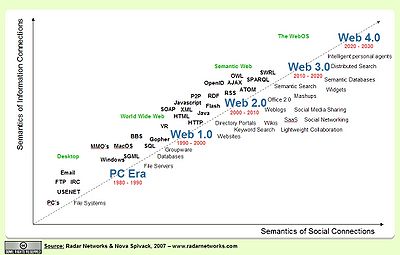Web 2.0: Difference between revisions
m (using an external editor) |
|||
| Line 21: | Line 21: | ||
* [[LAMS]] | * [[LAMS]] | ||
* [[microworld]]s (some) | * [[microworld]]s (some) | ||
; Web 20.0 in context | |||
{{quotation | Web 2.0 was really about upgrading the "front-end" and user-experience of the Web. Much of the innovation taking place today is about starting to upgrade the "backend" of the Web and I think that will be the focus of Web 3.0 (the front-end will probably not be that different from Web 2.0, but the underlying technologies will advance significantly enabling new capabilities and features).}} ([http://novaspivack.typepad.com/nova_spivacks_weblog/2007/02/steps_towards_a.html], retrieved 14:13, 27 April 2007 (MEST)) | |||
[http://novaspivack.typepad.com/nova_spivacks_weblog/2007/02/steps_towards_a.html timeline of the past, present and future of the Web]: | |||
[[image:RadarNetworksTowardsAWebOS.jpg|none|thumb|400px|Nova Spivack & Radar Networks Towards a WebOS]] | |||
== Old vs. new web services == | == Old vs. new web services == | ||
| Line 85: | Line 92: | ||
A few years ago, there was a lot of talk about the [[semantic web]]. This didn't happen so far ;). So more and more it appears that Web 2.0 means actually going back to the roots of academic Internet in the 80' and very early 90' which was all about communication and exchange. Internet/Web is also (and has been most of the time) about being easy, open and flexible. | A few years ago, there was a lot of talk about the [[semantic web]]. This didn't happen so far ;). So more and more it appears that Web 2.0 means actually going back to the roots of academic Internet in the 80' and very early 90' which was all about communication and exchange. Internet/Web is also (and has been most of the time) about being easy, open and flexible. | ||
== References == | |||
= | * Farber, Dan (2007), ''From semantic Web (3.0) to the WebOS (4.0)'', ZDNet Article, feb 14, 2007, [http://blogs.zdnet.com/BTL/?p=4499 HTML]. | ||
* O'Reilly, Tim, What Is Web 2.0 - Design Patterns and Business Models for the Next Generation of Software, [http://www.oreillynet.com/pub/a/oreilly/tim/news/2005/09/30/what-is-web-20.html HTML] | * O'Reilly, Tim, What Is Web 2.0 - Design Patterns and Business Models for the Next Generation of Software, [http://www.oreillynet.com/pub/a/oreilly/tim/news/2005/09/30/what-is-web-20.html HTML] | ||
Revision as of 13:13, 27 April 2007
Definition
Web 2.0 is one of those "buzz words" like DHTML that do not have a clear meaning but does refer to a trend or practise that does favor new technologies.
Web 2.0" referes to a certain kind of rich internet applications and means:
- New social webservices (see social computing) or at least webtops, virtual office etc.
- Improved user experience (e.g. AJAX)
- Both of these combined
- Examples (see also)
- DITA Storm
- Through the web editors
- Virtual offices, (some, i.e. in the sense of Office 2.0)
- Webtops
- Social software applications (most)
- Specifically for education (in this wiki)
- Personal learning environments (maybe some)
- LAMS
- microworlds (some)
- Web 20.0 in context
“Web 2.0 was really about upgrading the "front-end" and user-experience of the Web. Much of the innovation taking place today is about starting to upgrade the "backend" of the Web and I think that will be the focus of Web 3.0 (the front-end will probably not be that different from Web 2.0, but the underlying technologies will advance significantly enabling new capabilities and features).” ([1], retrieved 14:13, 27 April 2007 (MEST))
timeline of the past, present and future of the Web:
Old vs. new web services
According to Tim O'Reilly (2005), Web 2.0 can be defined through examples of how typical web services did evolve. E.g.
| Web 1.0 (past) | Web 2.0 (future) |
|---|---|
| Photo-albums | Flickr-like albums |
| FTP or http-based downloads | BitTorrent |
| mp3.com | Peer-to-peer solutions, like Napster |
| Britannica Online | Wikipedia |
| personal websites | blogging |
| publishing | participation |
| content management systems | wikis |
| directories (taxonomy) | tagging ("folksonomy") |
| stickiness | syndication |
What is common about these example is that “behind the success of the giants born in the Web 1.0 era who have survived to lead the Web 2.0 era appears to be this, that they have embraced the power of the web to harness collective intelligence” (O'Reilly, 2005), in other words Web 2.0 is strongly related to social computing and collective intelligence (the "wisdom of the crowd").
In addition, Web 2.0 is related to enhanced user experience and webservices standards and APIs that allow for more collaboration between machines (data exchange is usually XML-based).
Improved user experience
Jared Spool [2] points out the power of APIs: A very good example is Google Maps that allows anyone to overlay data onto any place that Google Maps can show. E.g. here is the place where these very words have been written.
See AJAX for the most popular technology used, but rich internet applications can be based on many other frameworks.
Relation to semantic web
A few years ago, there was a lot of talk about the semantic web. This didn't happen so far ;). So more and more it appears that Web 2.0 means actually going back to the roots of academic Internet in the 80' and very early 90' which was all about communication and exchange. Internet/Web is also (and has been most of the time) about being easy, open and flexible.
References
- Farber, Dan (2007), From semantic Web (3.0) to the WebOS (4.0), ZDNet Article, feb 14, 2007, HTML.
- O'Reilly, Tim, What Is Web 2.0 - Design Patterns and Business Models for the Next Generation of Software, HTML
- Spool, Jared M., Web 2.0: The Power Behind the Hype, HTML
